- HOME
- 【The New Era of Digitalization】How printable RFID tags are building the future
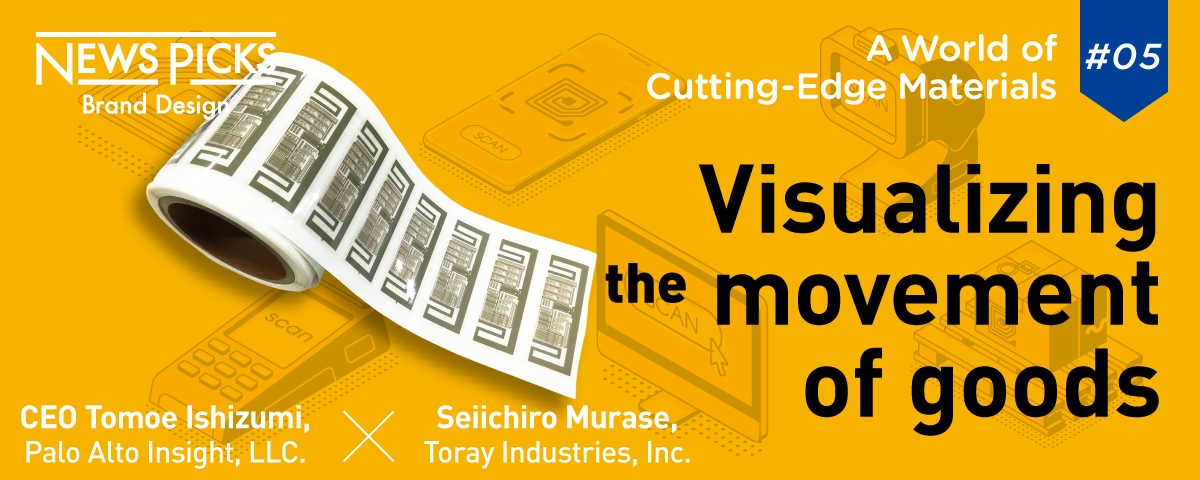
【The New Era of Digitalization】How printable RFID tags are building the future
From factories to warehouses, from distribution to retail, industries are looking to RFID tags to manage the next generation of digital management of the physical world. Despite active government promotion, the use of RFID tags has been limited by the difficulty of keeping printing costs under 1 yen. This January, Toray took aim at this bottleneck with their release of the printed RFID. How was this technology developed, and how will it change our lives and businesses going forward? We asked Seiichiro Murase of Toray Industries, Inc. and AI business designer Tomoe Ishizumi to break it all down for us.
■Everything gets a digital tag
──This January, Toray announced a new technology they call a “printed RFID.” What can it do?
Ishizumi: It’s going to bring a lot of changes in business across the supply chain, from manufacturing to logistics, retail, and the customer experience. The key point is that we’ll be able to read digital information from any object, without physical contact, in bulk.

After earning an MBA from Harvard Business School in 2010, Ishizumi led a number of AI projects as a senior strategist at Google's headquarters in Silicon Valley. She then went on to work in ventures working on HR tech and distribution AI, before starting Palo Alto Insight in Silicon Valley. Palo Alto Insight has built a network of data scientists to provide consistent AI support to Japanese companies, from proposing strategies to development The company is also developing content for AI-based human resources development.
The first big impact is on retail. Take UNIQLO, for example. They’ve been using RFID tags recently, and when I went shopping the other day, the scanner at the self-checkout line instantly read the ten or so items in my basket. I was shocked! It was so fast that I was worried it might have made a mistake or two, but it was perfectly accurate.
If this technology starts spreading, it’s going to dramatically change the shopping experience. We’ll see a lot more self-check-outs and unmanned stores. This technology is going to lead to big savings, not just in labor costs, but time as well. It’s really impressive.

Murase joined Toray in 1999, assigned to the Electronic & Imaging Materials Research Laboratories. After researching light-emitting materials for OLEDs, he was transferred to the carbon nanotube research team in 2006. During the course of his career, Murase has studied overseas, researched materials for solar cells and printing, and stayed engaged with carbon nanotube research. He has been leading the charge on printed RFID research since the very beginning.
Murase: In 2017, the Ministry of Economy, Trade and Industry (METI) announced that they wanted to see 100 billion electronic tags in convenience stores. The declaration said that they wanted RFIDs attached to every product on convenience store shelves by 2025. Since Japan’s population is in decline, a lot of us are looking at RFID as a way to make the whole retail and distribution more efficient.
Unlike conventional tags like barcodes or QR codes, RFID uses UHF radio waves to read information from up to five meters away—there’s no need to scan each tag individually. That’s why UNIQLO was able to scan Ms. Ishizumi’s purchases all at once.
But conventional silicon RFIDs are expensive to make. They sell for somewhere between ten and twenty yen a piece (USD $.09~$.18). That’s too expensive for a product that costs fifty yen or so at a convenience store. If we want to see RFIDs in more places, we need to bring the cost down.
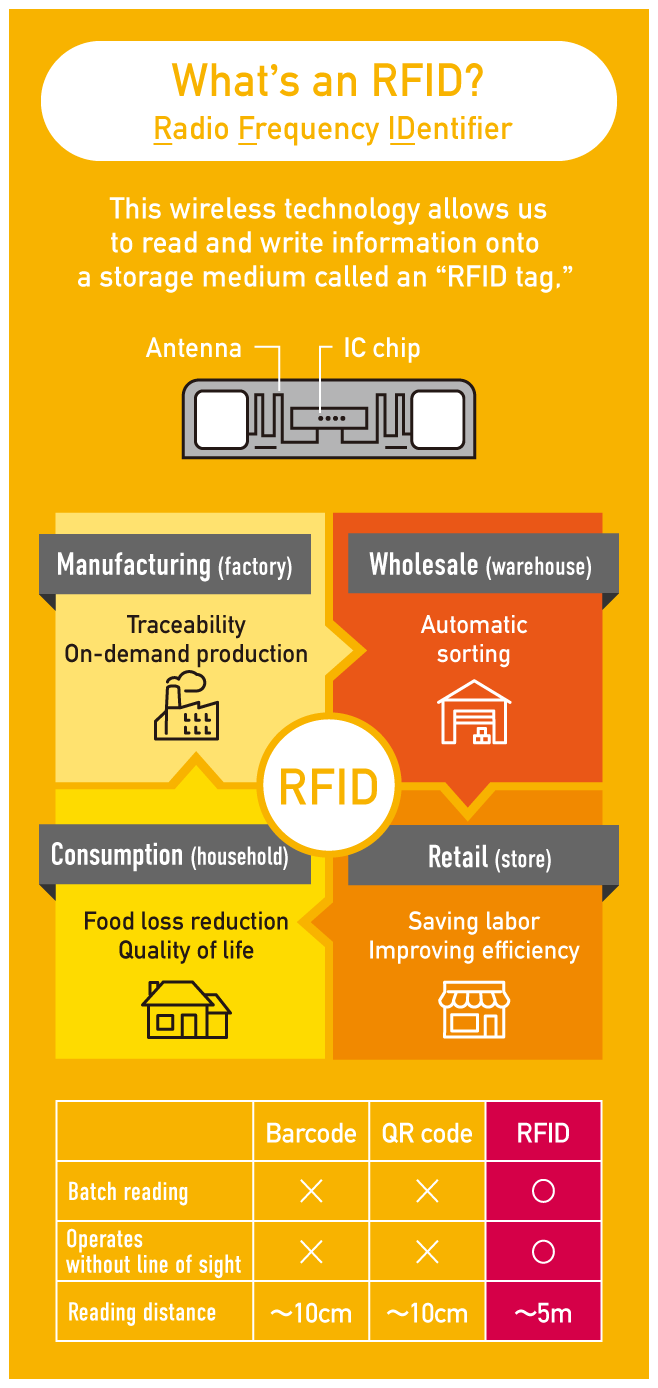
Ishizumi: From what I’ve read, Toray can print an RFID for about one-fifth the cost of previous RFID tags (*current target value). If they’re able to cut costs that low, then a much wider range of businesses will start introducing RFID tags. It’s a revolutionary material.
Because of COVID-19, I do most of my shopping online now. I’ve had a few times that a product was shown as in stock on an online store, but it was actually out of stock, and the store couldn’t deliver on time. It’s disappointing.
Retailers that handle a large number of products have an especially difficult time managing inventory in real time. Here in the U.S., Wal-Mart’s data showed that their inventory management was only 60% accurate, but it jumped up to 90% after they started using RFIDs.
If we can get a real time picture of what products are in the store and what’s still on trucks, we’ll have a lot more data to analyze with AI. When you start with insufficient data, forecasts of supply and demand will be biased.
Murase: Definitely. Human beings make mistakes when they read barcodes, loading products onto trucks and delivering them to stores. RFIDs let you count exactly how many units you have of any item, just by reading them through a cardboard box or on a truck platform.

Ishizumi: Not only that, but we can do things like attach RFIDs to workers’ clothing at a manufacturing site and get an accurate sense of where things are moving, we can analyze workflow. RFIDs help reduce human errors, and the data we collect can be fed into AI to improve labor management. There’s actually a chocolate factory in Canada that’s already doing this, running an RFID-based “smart factory.”
■New semiconductor to replace silicon
── When did Toray start researching RFIDs?
Murase: We started researching carbon nanotubes around 2000, and that led into studying printed RFIDs. Carbon nanotubes are light weight and strong, they have a lot going for them, but we started out focusing on their conductivity. I was trying to build something with carbon nanotubes as part of my personal research (Toray encourages researchers to spend 20% of their time on personal projects), and I realized that they would make great semiconductors.
Basically, they’re a bit like silicon.
They’re somewhere between a proper conductor and an insulator, so they’re useful as a switch to stop and start electron flow, depending on the voltage. We took off researching carbon nanotubes as semiconductors from there. In the course of exploring different applications, like flexible displays, we started looking into printed RFIDs.
Ishizumi: What’s the difference between a conventional RFID and Toray’s printed RFID?
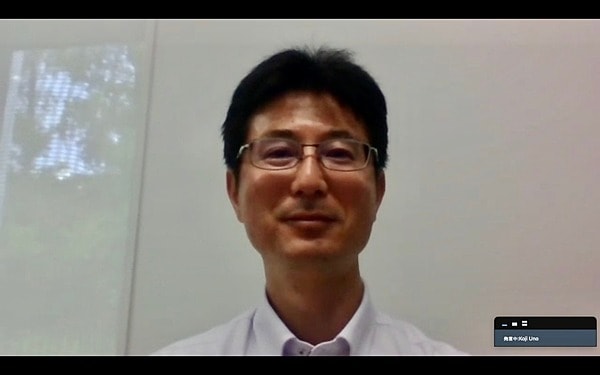
Murase: Conventional RFIDs are made from silicon. There’s a small circuit embedded in the tag, similar to the ones we find in computers.
But the manufacturing process for a silicon chip is complex; there are somewhere between 300 and 1,000 processes involved. Starting up a semiconductor plant costs billions of yen. Our printed RFID, on the other hand, only needs about 20 processes. It’s made by dripping a liquid containing semiconductor carbon nanotubes onto a film, so we can mass produce them without building a large-scale factory.
The METI declaration I mentioned earlier, the call for 100 billion electronic tags in convenience stores, had another condition: each tag needs to cost less than 1 yen. We couldn’t get there with silicon, but with semiconductor nanotubes, it’s looking more and more possible.
Ishizumi: If printed RFIDs are so much cheaper, why haven’t other companies tried it?
Murase: Well, researchers all over the world knew that printed tags could be done cheaply. It just wasn’t technically possible yet.
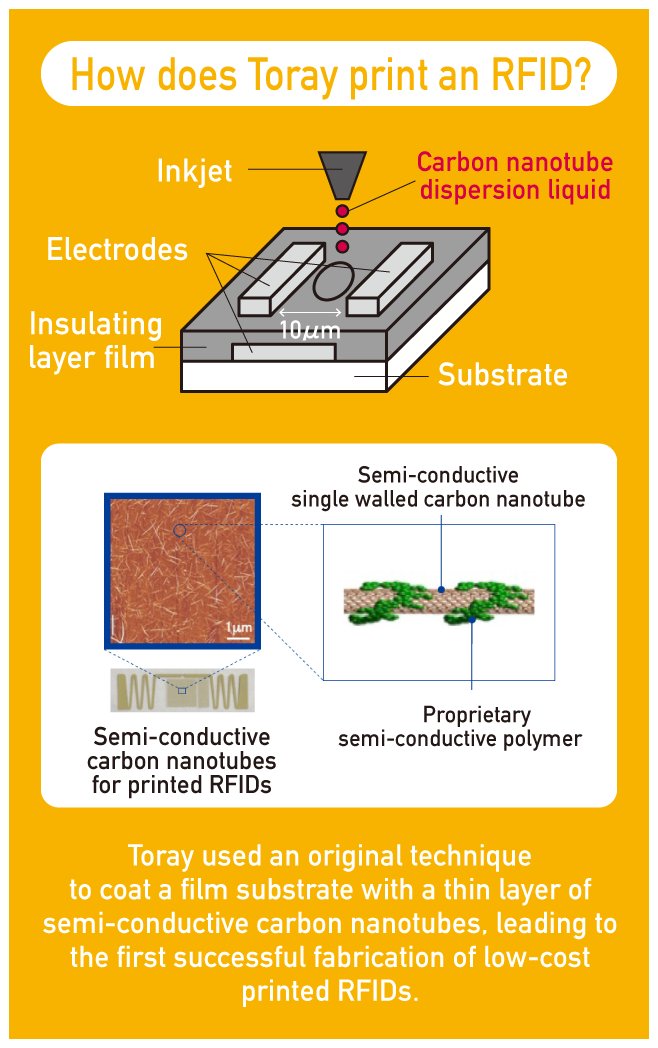
In a printed RFID, a liquid spray of carbon nanotube semiconductors replaces conventional silicon chips. By taking carbon nanotube semiconductor technology to its absolute limit, Toray achieved the world’s highest level of semiconductor performance.
That was a key step toward printed RFIDs, but it wasn’t the whole story. We also needed to place electrodes along the coated film at an interval of 10 micrometers. Current printing and coating techniques aren’t up to the task. We were able to draw on another technology from touch panels, though, using photosensitive conductive paste. Combining those two technologies is what finally led to the latest design in printed RFIDs. It took us twenty years! (laughs)
Ishizumi: I’m trying to imagine how they could actually be used in the field. They’re about a centimeter in size, aren’t they? How thick are they?
Murase: Less than 100 micrometers. Less than a tenth of a millimeter.
Ishizumi: That’s nothing! (laughs) Can they do the things a silicon RFID can do?
Murase: They’re basically the same, but there are limitations on performance. Existing RFIDs have a communication distance of about 5 meters, but printed RFIDs are limited to about 1 meter. They can store about 60 bits of data.
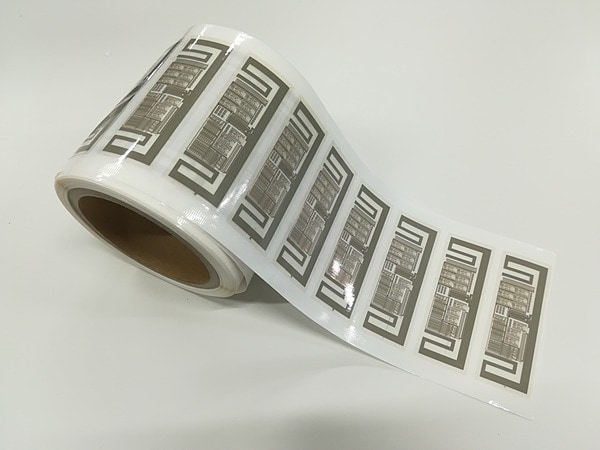
Photograph: Courtesy of Toray
Now remember, 60 bits can store about 1 quintillion digits. That means we could tag every product in the world for hundreds of years and never run out of RFID tags. Going forward, our carbon nanotube semiconductors will probably be used alongside silicon RFID tags, and we’ll use them for different purposes.
Businesses are going to come up with all kinds of ways to use this once it hits the market, so as a materials manufacturer, I think it’s important to develop the technology properly and release it as soon as possible.
■The Future of materials: From tangible to intangible
Ishizumi: As someone working on ways to use AI in business, this really gets me thinking.
We talk a lot about big data, but only 40% of American companies are using AI, and only 14% of Japanese companies are.
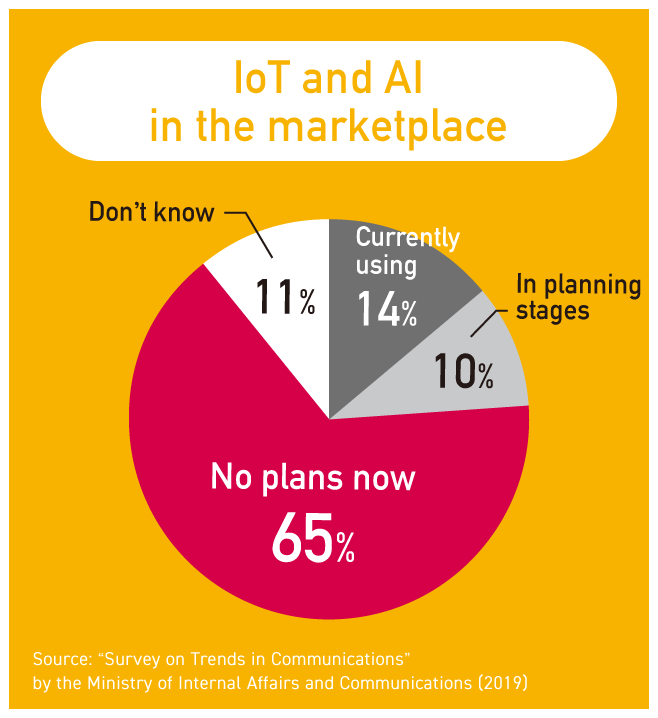
Most of the data we’re using is online and on devices—we have nowhere near enough data from offline sources. Even when we do gather data, it can be hard for AI developers to use, or it’s too tied up in consumers’ information to be useful.
Since printed RFIDs will be at the very top of the value chain, they’re going to be a key data source. Businesses are going to think carefully about how to use that data, and that’s going to lead to some real breakthroughs in machine learning and data analysis.
Drive recorders are a business I’ve been working with that has a lot of parallels. It depends on the type of recorder, but they take in a lot of different kinds of data; not just images, but also things like the angle of gravity, and they collect it every second. They really are a source of big data. But when we try to analyze that data, it’s not tagged or labeled.
Murase: Ah, I see. That’s an important point. You can’t extract or compare data in an organized way without attaching labels to it.
Ishizumi: Exactly. Say you wanted to look at just the information on a particular accident, and use that data to explore the causes of accidents and try to predict them. You need data that’s tagged to tell you which events are actually accidents and whether it was just a tiny bump or a violent collision. If that information isn’t standardized with the same level of granularity across the data set, you can’t make any comparisons.
Murase: The information that goes into our printed RFID is a series of numbers, but the number of digits is so large that it can make a unique, non-repeating identifier.
It only produces data when there’s a reader to read the information off of it. The process of labeling the data and linking it together with computers and services will need to be developed together with the manufacturers that produce those readers and systems. We’re starting to talk through those issues now.
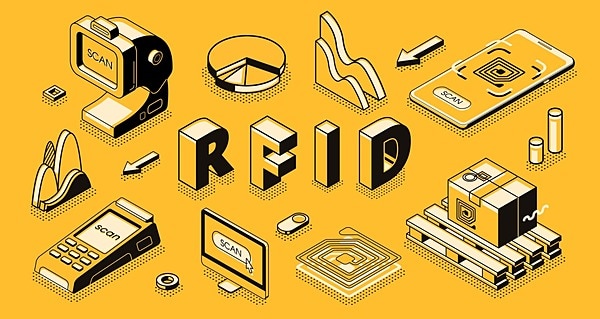
istock/Best Content Production Group
Ishizumi: So you’re moving forward on implementation?
Murase: We’ve had inquiries from more than 100 companies and organizations since we released our press release in January. We’re very grateful.
That said, the first thing we need to do is to refine the technology and show the world how useful it could be. There are still a lot of things we need to do as a materials manufacturer to make that happen. If this were mountain climbing, I’d say we’re still near the base, at the third or fourth station.
Ishizumi: Twenty years of research, and you’re still at the fourth station? You’ve got a long road ahead, then.
Murase: Definitely. Toray has been researching carbon nanotubes for twenty years, and I’ve personally been at it for fifteen. The more you work with these new materials, the more you understand how difficult it really is.
We’re looking toward the future and all of these expanding possibilities, but at the same time, we’re thinking about what kinds of problems we’ll need to deal with, what kinds of applications can take advantage of the potential in this material. We didn’t know anything at the outset, so it’s been a long process of trial and error.
At this point, I think we’ve finally found the right level of technology and a road ahead for releasing it into the world. Delivering it as a product won’t be easy.
Your book, Ms. Ishizumi, has a very interesting key word: “koto-zukuri” (creating intangible things). Here at Toray, we make materials, but that’s a topic here, too. We need to create applications and experiences. We have to get involved in “koto-zukuri” ourselves. When we can get to that point and make a change in the world, then we’re no longer at the third or fourth station on the mountain. That’s when we can say that we’re getting close to the mountain’s summit.
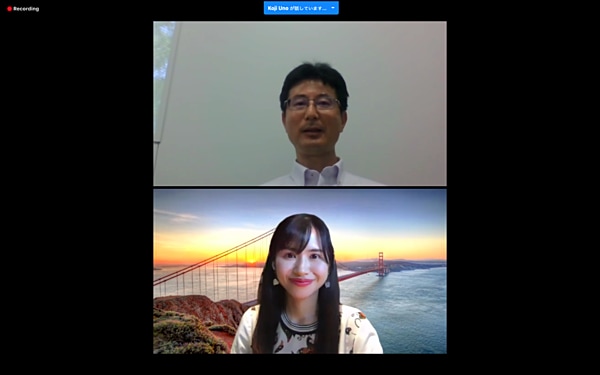
Ishizumi: That’s absolutely right. Even though RFIDs and AI are dealing with data from different directions, this talk has me thinking that they really do have similar goals.
To the extent that human beings have been restricting their movement and contact under COVID-19, the movement of goods has increased. RFIDs are like a sensor, telling us what things are placed where. My job is to figure out what data we can pull from that, and how we can combine it with AI and other technologies to design a business.
I hope printed RFIDs will become mainstream as soon as possible.
Produced by: NewsPicks Brand Design
Edited by: Koji Uno
Written by: Tadayoshi Sugiyama
Design: Kana Tsutsumi
